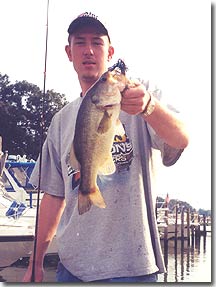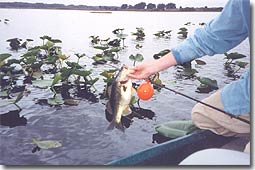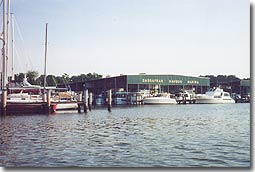All experienced anglers know that on specific bodies of water, there are always certain spots that produce the best bass year after year. When you have fished your best spot, and it is unproductive, do you move to another spot, or stay there hoping for the bass that you know are there to start hitting?
In my 35 years of experience, I have found that you should leave a reliable spot only after you have tried your best, with a variety of time proven baits. This has been proven to me over and over, on a variety of Lakes and Rivers in the country. More times than I can remember, we came right in behind another angler and caught bass right out of the area that they just worked with only one bait, and moved on.
 The top places to catch bass on almost any lake in the country are Docks, Sloping Gravel/Sand Points, Shoreline Drop-offs, and Dense Cover near deep water.
The top places to catch bass on almost any lake in the country are Docks, Sloping Gravel/Sand Points, Shoreline Drop-offs, and Dense Cover near deep water.
The dense cover such as hyacinth, milfoil, Hydrilla, different varieties of pads, reeds and other grasses, are one of the best areas to big bass. The drop-offs with rocky, sandy, and/or gravel points running into deeper water, with some other structure mixed in at the ends of the points, seems best, and of course boat docks and piers. Never overlook the docks and piers. We have had many a slow day on the Sassafras and Nanticoke, only to switch lures and presentations, in the marinas and boat docks, and catch that one kicker fish or sometimes the biggest bass of the day.
If you check most any pro bass fisherman's outfits, you will usually see these 5 lures tied on, (provided you can get a look at them). They will be a buzzbait, a crankbait, a spinnerbait, a Carolina and/or Drop-Shot rig, and a Jig. There will be many other rods, and other lures ready to use but, these are the mainstay of baits for most any situation in the country. The following strategies should help you thoroughly cover the water from top to bottom.
 DROP-OFF SHORES / GRAVEL POINTS: I always look at the way the land around the lake goes into the water. That land usually continues out into the water the same way. Move to within about 25-35 feet from shore, and cast directly to the area with a buzzbait, cutting the water like a piece of pie, over and over, at different speeds and angles. Next, cast the spinnerbait against the shore and work the area at different depths and speeds. Then do the same thing with the crankbait. I use a deep diver for this so it can get down quickly and bounce off rocks, sand, stumps, on the bottom, or mid-depth. I then cast the same area with a Carolina rig, with a French Fry worm, a cut-tail worm, or a Senko. I change boat positions often to work this and the other baits at many angles to the drop-off shore. I stair-step the jig down any rock ledges, and crawl/hop it down the edge of the point where it meets deeper water. I use a smaller Terminator jig for this. On the Gravel/Sandy points, I do the same thing as when I'm Drop-off shores. The color of the water should dictate what color baits to use. If the water is muddy, use louder baits, in black,black/red, Black/Brown combinations; if the water is clear, I pick more natural colors for the baits, and a less noisy model.
DROP-OFF SHORES / GRAVEL POINTS: I always look at the way the land around the lake goes into the water. That land usually continues out into the water the same way. Move to within about 25-35 feet from shore, and cast directly to the area with a buzzbait, cutting the water like a piece of pie, over and over, at different speeds and angles. Next, cast the spinnerbait against the shore and work the area at different depths and speeds. Then do the same thing with the crankbait. I use a deep diver for this so it can get down quickly and bounce off rocks, sand, stumps, on the bottom, or mid-depth. I then cast the same area with a Carolina rig, with a French Fry worm, a cut-tail worm, or a Senko. I change boat positions often to work this and the other baits at many angles to the drop-off shore. I stair-step the jig down any rock ledges, and crawl/hop it down the edge of the point where it meets deeper water. I use a smaller Terminator jig for this. On the Gravel/Sandy points, I do the same thing as when I'm Drop-off shores. The color of the water should dictate what color baits to use. If the water is muddy, use louder baits, in black,black/red, Black/Brown combinations; if the water is clear, I pick more natural colors for the baits, and a less noisy model.
DENSE COVER: This is my favorite type of cover to work. First I cast a buzzbait wherever possible, working it in and out of cover at varies angles and retrieves. When the water is really calm, I throw a real small buzzbait that works very slowly on the surface. I have clear skirts, pearl skirts, and other subtle natural colors that I can easily switch. I then throw the spinnerbait, working it in and out of the pockets in the pads, making it turn quickly, then flutter down, and even bulge the surface. I work it a variety of ways until the bass dictate what they want to me. When in the River I make sure I bump into every limb of the tree with the bait at every angle before going to the next bait. If they don't hit a Fat bodied crankbait around the edges, or dead sticked in the open pockets, then I switch to a Tournament Frog, or Rat, and work this in a variety of conventional and unconventional ways. If this is a good area, and I don't get any hits with these baits, then I would throw the Carolina rig and the jig around the edges of the cover, and right into any pockets in the cover.
 DOCKS: These areas always produced for us on sunny days, whether it was in the river or a lake, especially in the summer and early fall. You should approach the docks quietly, and start to work them from farther away with each lure type. Only when they don't hit these other baits first, should you then move in with the jig and Senko, and flip each piling on the dock, then skip the Senko under the dock as far as possible. There are many more tactics you could try if you aren't getting any takers from your best spots, but these are the basics that you should practice every time you go to get into the habit of doing these things. It will become second nature, and you will notice the results in your local or club tournament wins, or your recreational fun.
DOCKS: These areas always produced for us on sunny days, whether it was in the river or a lake, especially in the summer and early fall. You should approach the docks quietly, and start to work them from farther away with each lure type. Only when they don't hit these other baits first, should you then move in with the jig and Senko, and flip each piling on the dock, then skip the Senko under the dock as far as possible. There are many more tactics you could try if you aren't getting any takers from your best spots, but these are the basics that you should practice every time you go to get into the habit of doing these things. It will become second nature, and you will notice the results in your local or club tournament wins, or your recreational fun.
More Articles
Steve vonBrandt
Delaware Bass Fishing

